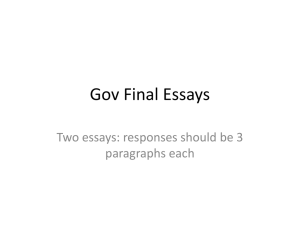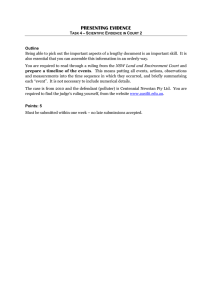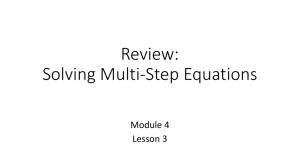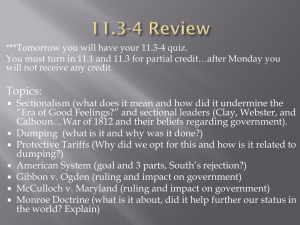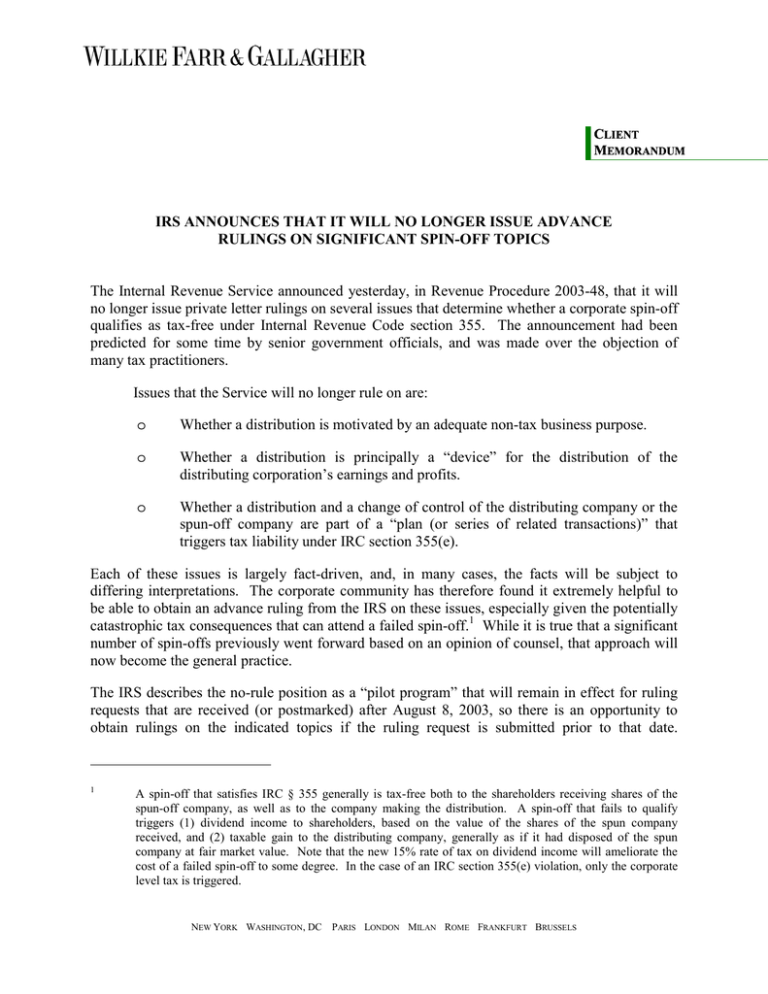
CLIENT
MEMORANDUM
IRS ANNOUNCES THAT IT WILL NO LONGER ISSUE ADVANCE
RULINGS ON SIGNIFICANT SPIN-OFF TOPICS
The Internal Revenue Service announced yesterday, in Revenue Procedure 2003-48, that it will
no longer issue private letter rulings on several issues that determine whether a corporate spin-off
qualifies as tax-free under Internal Revenue Code section 355. The announcement had been
predicted for some time by senior government officials, and was made over the objection of
many tax practitioners.
Issues that the Service will no longer rule on are:
o
Whether a distribution is motivated by an adequate non-tax business purpose.
o
Whether a distribution is principally a “device” for the distribution of the
distributing corporation’s earnings and profits.
o
Whether a distribution and a change of control of the distributing company or the
spun-off company are part of a “plan (or series of related transactions)” that
triggers tax liability under IRC section 355(e).
Each of these issues is largely fact-driven, and, in many cases, the facts will be subject to
differing interpretations. The corporate community has therefore found it extremely helpful to
be able to obtain an advance ruling from the IRS on these issues, especially given the potentially
catastrophic tax consequences that can attend a failed spin-off.1 While it is true that a significant
number of spin-offs previously went forward based on an opinion of counsel, that approach will
now become the general practice.
The IRS describes the no-rule position as a “pilot program” that will remain in effect for ruling
requests that are received (or postmarked) after August 8, 2003, so there is an opportunity to
obtain rulings on the indicated topics if the ruling request is submitted prior to that date.
1
A spin-off that satisfies IRC § 355 generally is tax-free both to the shareholders receiving shares of the
spun-off company, as well as to the company making the distribution. A spin-off that fails to qualify
triggers (1) dividend income to shareholders, based on the value of the shares of the spun company
received, and (2) taxable gain to the distributing company, generally as if it had disposed of the spun
company at fair market value. Note that the new 15% rate of tax on dividend income will ameliorate the
cost of a failed spin-off to some degree. In the case of an IRC section 355(e) violation, only the corporate
level tax is triggered.
NEW YORK WASHINGTON, DC
PARIS LONDON MILAN ROME FRANKFURT BRUSSELS
However, once it takes effect, the no-rule position will be absolute. Unlike other situations in
which the Service reserves the right to rule in particular cases, rulings will never be provided on
the indicated issues.
In connection with the no-rule announcement, the IRS released three related items of guidance:
i.
Minimum active business. Since 1996, it has been the position of the IRS that
it would ordinarily not rule whether a business satisfies the IRC section
355(b) “active trade or business” test if the assets comprising the 5-year active
trade or business had a gross value of less than 5% of the gross value of the
assets of the distributing company, or the spun-off company, as applicable.2
Rev. Proc. 2003-48 removes this issue from the no-ruling list, indicating,
apparently, that the IRS is now prepared to consider ruling in situations in
which the 5-year active business represents less than 5% of the assets of the
distributing or spun-off company.
ii. “Fit and focus” ruling. Revenue Ruling 2003-74 holds that a software
company’s spin-off of a paper products business satisfies the IRC section 355
business purpose requirement, since the distribution was motivated by a
desire to allow senior management of the distributing company “to
concentrate its efforts on the software business, which it believes presents
better opportunities for growth, and allow the management of the paper
products business to secure for that business the management resources
needed for its full development.”
Although the ruling is not particularly noteworthy from a substantive
perspective, it represents the Service’s first published guidance addressing the
so-called fit and focus business purpose.3 The ruling also indicates that in
some situations, the existence of common directors of the distributing
company and the spun-off company will not impair reliance on the fit and
focus business purpose.
iii. Resolution of capital allocations between distributing and spun-off
companies; continuing relationships between companies. Revenue Ruling
2003-75 confirms that certain continuing relationships between the
distributing and spun-off companies will not jeopardize a tax-free spin-off. In
2
See Rev. Proc. 2003-3, 2003-1 I.R.B. 113 §4.01(30), prior to amendment by Rev. Proc. 2003-48. Under
IRC section 355(b) both the distributing company and the spun-off company must be actively engaged in a
trade or business that has been conducted for at least 5 years prior to the spin-off.
3
Rev. Proc. 96-30, 1996-1 C.B. 696, Appendix A, had set forth the criteria for advance rulings dealing with
the fit and focus business purpose, but the revenue procedure is modified to delete the criteria as part of the
no-rule program laid down by Rev. Proc. 2003-48.
-2-
the facts of the ruling, the distribution was made to resolve issues relating to
competition for capital between two businesses.
After the spin-off,
transitional agreements relating to information technology, benefits
administration and accounting and tax matters were entered into, and will
generally continue for a period of two years absent extraordinary
circumstances, in which case the agreement would be re-negotiated on arm’s
length terms for a limited period. The Service also stated there would be no
cross-guarantee or cross-collateralization of debt between the two companies,
although a working capital loan would be in existence for a period of two
years. A “tax agreement” – presumably allocating tax costs and risks
associated with the spin-off (such as tax due to subsequent change of control
of one of the companies under IRC section 355(e)) – would remain in effect.
Again, the ruling is not particularly interesting from a substantive perspective.
However, arrangements between the distributing company and the spun-off
company that extend materially beyond 2 years could be at risk of an IRS
challenge by reason of the ruling.
Observations
It seems likely that interested parties will object to the new no-rule position. The inability to
obtain advance rulings in spin-offs can expose the participants to significant risks of liability, of
a type that has little other analogue in tax planning for ordinary commercial transactions.
Presumably most transaction participants would be only too happy to reimburse the
government’s expenses of issuing rulings in this area. At the same time, these arguments have
already been made to government officials and to date have been unavailing.
If the no-rule policy stands – as it appears that it will, at least for the time being – it will
obviously place significant pressure on practitioners to determine whether proposed spin-off
transactions can satisfy the IRC section 355 criteria. An opinion, however, can never provide a
definitive resolution of issues it addresses. It remains to be seen, but one can imagine that the
inability to obtain definitive resolution of issues relating to business purpose, device, or
IRC section 355(e) plan will mean that the transaction structures may need to be adjusted, or
other steps taken, in order to proceed with a desired transaction.
Please feel free to call Henry M. Cohn, Andrew W. Needham, Richard L. Reinhold or Jeffrey
Van Hove if you wish to discuss the new revenue procedure, or related rulings.
-3-
Willkie Farr & Gallagher is headquartered at 787 Seventh Avenue, New York, NY 10019. Our
telephone number is (212) 728-8000 and our facsimile number is (212) 728-8111. Our website is
located at www.willkie.com.
June 25, 2003
Copyright © 2003 by Willkie Farr & Gallagher.
All Rights Reserved. This memorandum may not be reproduced or disseminated in any form without the express permission of
Willkie Farr & Gallagher. This memorandum is provided for news and information purposes only and does not constitute legal
advice or an invitation to an attorney-client relationship. While every effort has been made to ensure the accuracy of the
information contained herein, Willkie Farr & Gallagher does not guarantee such accuracy and cannot be held liable for any errors
in or any reliance upon this information.
-4-

